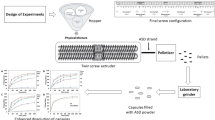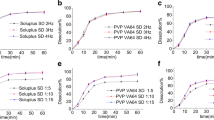Abstract
Purpose. This study was done to elucidate the physical and pharmaceutical properties of itraconazole-HPMC dispersions and the influence of water on the phase separation.
Methods. Extrudates were prepared using a corotating twin-screw hot-stage extruder with fixed process parameters. Modulated-temperature differential scanning calorimetry (MTDSC) and DSC 111 were used to examine the mixing behavior of itraconazole and the carrier by evaluation of the glass transition region. High temperature diffuse reflectance infrared transform spectroscopy (HT-DRIFT) was performed to reveal interactions between itraconazole and HPMC. Dissolution was performed to investigate the pharmaceutical performance of the dispersions.
Results. Although the dissolution rate of itraconazole significantly increased, we found that the solid dispersions do not form a homogeneous system. A different picture was obtained depending on the way MTDSC analysis was performed, i.e., using open or closed sample pans. Water can evaporate in open pans, which allows itraconazole to interact with HPMC and leads to a partially mixed phase. Analysis in hermetically closed pans revealed a further phase separation as water remains on the sample and impedes the interaction between drug and polymer.
Conclusions. Solid dispersions of itraconazole and HPMC do not form a homogeneous phase.
Similar content being viewed by others
REFERENCES
J. A. Barone, J. G. Koh, R. H. Bierman, J. J. Colaizzi, K. A. Swanson, M. C. Gaffar, B. L. Moskovitz, W. Mechlinski, and V. Van De Velde. Food interaction and steady-state pharmacokinetics of itraconazole capsules in healthy male volunteers, Antimicrob. Agents Chemother. 37:778–784 (1993).
S. M. Grant and S. P. Clissold. Itraconazole: a review of its pharmacodynamic and pharmacokinetic properties, and therapeutic use in superficial and systemic mycoses. Drugs 37:310–344 (1989).
G. L. Amidon, H. Lennernäs, V. P. Shah, and J. R. Crison. Theoretical basis for a biopharmaceutical drug classification: the correlation of in vitro drug product dissolution and in vivo bioavailibility. Pharm. Res. 12:413–420 (1995).
D. Q. M. Craig. The mechanism of drug release from solid dispersions in water-soluble polymers. Int. J. Pharm. 231:131–144 (2002).
C. Leuner and J. Dressman. Improving drug solubility for oral delivery using solid dispersion. Eur. J. Pharm. Biopharm. 50:47–60 (2000).
K. Six, C. Leuner, J. Dressman, G. Verreck, J. Peeters, N. Blaton, P. Augustijns, R. Kinget, and G. Van den Mooter. Thermal properties of hot-stage extrudates of itraconazole and Eudragit E100: Phase separation and polymorphism. J. Therm. Anal. Cal. 68:591–601 (2002).
G. Verreck, K. Six, G. Van den Mooter, L. Baert, J. Peeters, and M. E. Brewster. Characterization of solid dispersions of itraconazole and hydroxypropylmethylcellulose prepared by melt extrusion, part 1. Int. J. Pharm. 251:165–174 (2003).
K. Six, G. Verreck, J. Peeters, P. Augustijns, R. Kinget, and G. Van den Mooter. Characterization of glassy itraconazole: a comparative study of its molecular mobilty below Tg with that of structural analogues using MTDSC. Int. J. Pharm. 213:163–173 (2001).
K. Six, G. Verreck, J. Peeters, K. Binnemans, H. Berghmans, P. Augustijns, R. Kinget, and G. Van den Mooter. Investigation of thermal properties of glassy itraconazole: identification of a monotropic mesophase. Thermochim. Acta 376:175–181 (2001).
T. A. Instruments. Modulated DSC Compendium 1997. TA-Instruments, New Castle, Delaware.
M. Reading, D. Elliot, and V. Hill. MDSC, a new approach to the calorimetric investigation of physical and chemical transitions. J. Thermal Anal. 40:949–955 (1993).
M. Reading, A. Luget, and R. Wilson. Modulated differential scanning calorimetry. Thermochim. Acta 238:295–307 (1994).
S. Gordon and J. S. Taylor. Ideal copolymers and the second-order transitions of synthetic rubbers. I Non-crystalline copolymers. J. Appl. Chem. 2:493–500 (1952).
F. N. Kelley and F. Bueche. Viscosity and glass temperature relations for polymer-diluent systems. J. Pol. Sci. 50:549–556 (1961).
R. Simha and R. F. Boyer. General relation involving the glass transition temperature and coefficient of expansion of polymers. J. Chem. Phys. 37:1003–1007 (1962).
T. Matsumoto and G. Zografi. Physical properties of solid molecular dispersions of indomethacine with PVP and PVPVA in relation to indomethacine crystallization. Pharm. Res. 16:1722–1728 (1999).
G. Van den Mooter, M. Wuyts, N. Blaton, R. Busson, P. Grobet, P. Augustijns, and R. Kinget. Physical stabilization of amorphous ketoconazole in solid dispersions with polyvinylpyrrolidone K25. Eur. J. Pharm. Sci. 12:261–269 (2001).
Author information
Authors and Affiliations
Corresponding author
Rights and permissions
About this article
Cite this article
Six, K., Berghmans, H., Leuner, C. et al. Characterization of Solid Dispersions of Itraconazole and Hydroxypropylmethylcellulose Prepared by Melt Extrusion, Part II. Pharm Res 20, 1047–1054 (2003). https://doi.org/10.1023/A:1024414423779
Issue Date:
DOI: https://doi.org/10.1023/A:1024414423779




